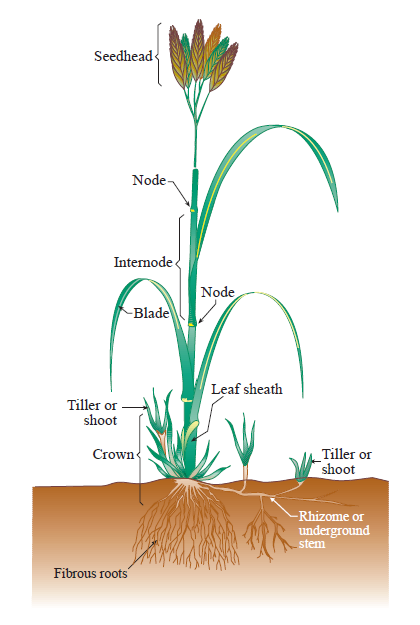Taxonomy and Linnaean classification
The taxonomical classification of grasses is shown below;
- Kingdom; – Plantae
- Phylum; – Magnoliophyta (angiosperms/ flowering plants)
- Class; – Liliopsida (monocotyledonous plants)
- Order; – Poales (Graminoid order)
- Family; – Poaceae (grass family)
- Genus; – Poa
- Species; – Various species
Introduction, Physical Description and Geographical Range
Grasses can be described as herbivorous plants which have narrow leaves growing from the plant base. They are dominant vegetation in many places such as forests, grasslands and in swampy regions. Grasses are found in almost every terrestrial habitant and some have been modified to suit mans needs. The grass species exceed 9000 making them one of the largest biological families in the world.
Plant description
The grass plant is comprised of tillers/ shoots that grow from the bud at the plant base. The tiller is comprised of leaf, stem node and the stem internodes. These units regularly repeat themselves. The leaves are attached to the stem at the internodes. The stems are hollow and are refereed to as culms. The leaves grow at one plane (distichous) and are parallel veined. The leaves have two parts; the lower sheath where it hug on the stem and a blade which has sharp edges to prevent grazing. The flowers are usually arranged as spikelets. These spikelets have one or more florets.
At the early growth stages of the plant, the nodes distance (internodes) is very small and the stem remains at the base of the plant. As the development progresses, the tiller stops to produce leaves and forms an immature seed head. When this happens, the tiller no longer grows and clipping it off or grazing does not affect the leaf growth of the grass. At this stage, the upper internodes elongate, new tillers emerge while the seed head increases in length.

Figure 1: the different parts of a grass plant [source: Banhart, 1 ]
Reproductive Habits and Life Cycle
There are three main development stages of grasses, these are;
Vegetative growth
Leaves: At an early stage, the leaves form at the stem near the ground. The leaves develop chlorophyll and photosynthesis occurs fast so that they capture solar energy to enable the formation of carbohydrates. The excess carbohydrates are stored in the roots and the plant crown. Normally, the leaves produced during spring die and the carbohydrates stored at the crown help in new leaf development during summer (Chapman 73).
Roots: The primary root developments occur during the initial growth stages and it feeds the initial leaves. These roots last for a few weeks and die. Secondary roots develop at the same time with tillers. This growth is supported by the carbohydrates produced by the leaves. The secondary root lasts for one year and aid in anchoring the plant. Other types of root that develop are the hair roots that aid in food absorption. Leguminous grasses produce an extensive root system beneath the soil comprised of stolons and rhizomes.
Elongation
At the elongation stage, the stem of the grass lengthens, at this stage only the upper internodes increase in length.
Reproductive Growth
At the reproductive stage, the seed head develops. This occurs after one year of vegetative growth and is controlled by the plant hormones that stimulate the reproductive meristems to start growing. During this stage, the reproductive parts elongate and form the crown. The crown produces flowers through which pollination occurs and seeds are formed (Barnhart 3).
Ecology
The grasses occupy the grassland biomes. They cover about 31% of the total earth planet. There are situated at the lowest level of the food chain as they form the food for many grazing animals such as cattle, goats, elephants, deer’s among others. Grasses are effective colonizers of any cleared land as compared to trees because they don’t have woody stems that are trampled by animals.
Plants have adaptations that prevent excessive grazing, their leaves have very sharp edges that cut the grazers and these prevent grazing. Some gases have hardened leaves. However, Grazing at the later stages of grass development removes the old unwanted stems and it is useful in the re-growth of the grass (Cheplick 125).
Human Impacts, Importance and Management
Grasses have numerous economic importances both to humans and animals. They are foods to herbivores that are later eaten by the carnivores and hence together with other plants, they sustain the entire food chain. They also form food for domestic grazing animals such as cattle, goats and sheep which become human foods. Grasses are also extensively used by humans for beautification, in lawns and in modern football, cricket and golf fields.
Grasses also affect agriculture, farmers must clear grasses during weeding and this increases their farming costs.
Human beings have great impacts on the grasses. Gradual encroachment of the grassland has reduced its cover. Practices such as; burning grass, unmanaged grazing, clearing land for agriculture, using land for building and construction have impacted negatively on this species.
With the continuous changes in climate and changes in weather patterns, it is expected that the grass population will continue to reduce. Unexpected weather conditions such as long dry seasons and short rain result to the grasses dying up.
Works Cited
Barnhart, Stephen. How pasture plants grow. 2012. Web.
Chapman, Geoffrey. The Biology of Grasses, 1st ed, Wallingford, Oxfordshire: CABI publishers, 1996. Print.
Cheplick, G. Population Biology of Grasses, Cambridge: Cambridge University Press, 1998. Print.